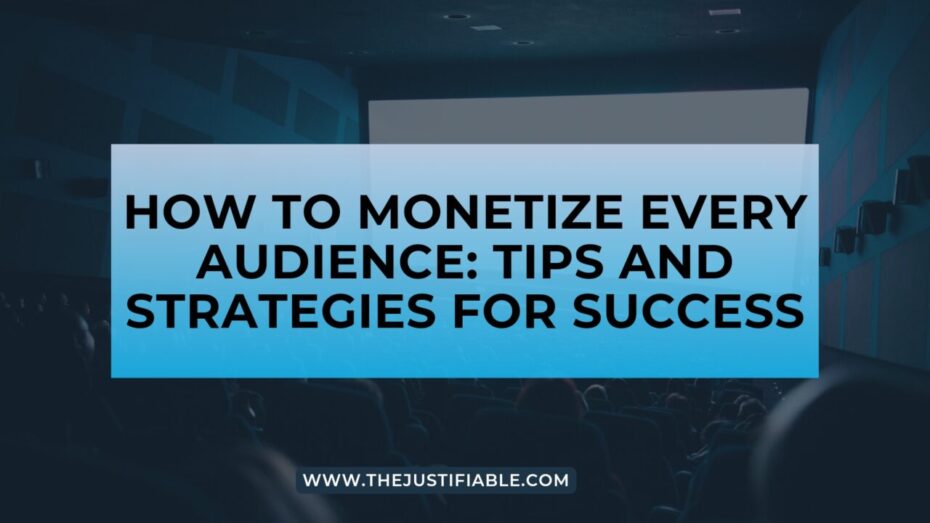How to monetize every audience? In today’s digital age, audience monetization has become an essential component of the success of any online business or content creator. Monetizing your audience entails earning money from people who read your content, buy your products or services, or visit your website.
This article will provide an in-depth guide to audience monetization, highlighting the best strategies and techniques for generating revenue from your audience.
Understanding Audience Monetization: A Comprehensive Guide
The process of generating revenue from people who consume your content, use your products or services, or visit your website is known as audience monetization. Depending on the type of content or service you offer, you can use a variety of strategies and techniques to monetize your audience.
Targeted advertising, affiliate marketing, content marketing, sponsorships, subscription models, and e-commerce integration are some of the most common strategies.
Top Strategies for Revenue Generation through Audience Monetization
To generate revenue through audience monetization, you must use the appropriate strategies and techniques for your business or content niche.
Targeted advertising, affiliate marketing, content marketing, sponsorships, subscription models, freemium models, e-commerce integration, in-app purchases, digital products, pay-per-click advertising, native advertising, influencer marketing, and conversion optimization are some of the top strategies for revenue generation through audience monetization.
Targeted Advertising: Reaching the Right Audience for Maximum ROI
Targeted advertising is an effective method for reaching the right audience and maximizing ROI. It entails showing ads to people who, based on their demographics, interests, and behavior, are most likely to be interested in your products or services. You can improve the effectiveness of your ad campaigns and maximize your return on investment by using targeted advertising.
To implement targeted advertising, you must first identify and understand your target audience’s demographics, interests, and behavior. Then, you can create targeted campaigns that reach your ideal audience using various advertising platforms such as Google Ads, Facebook Ads, or LinkedIn Ads.
It’s also critical to track and analyze the performance of your ad campaigns, using metrics like click-through rate, conversion rate, and cost per acquisition to maximize the effectiveness of your campaigns.
How Affiliate Marketing Can Help Monetize Your Audience
Affiliate marketing is an effective way to monetize your audience by promoting the products or services of others and earning a commission for each sale or lead generated. It’s a win-win situation for both the affiliate and the product/service owner, as the affiliate can earn passive income by promoting products that align with the interests of their audience, and the product/service owner can reach a larger audience and generate more sales or leads.
To begin implementing affiliate marketing, you must first identify the appropriate affiliate programs that correspond to the interests and needs of your target audience. To find relevant products or services to promote, you can join affiliate networks such as FlexOffers, Awin, or ShareASale. It’s also important to promote products or services that you believe in and have used yourself, as this will boost your credibility and trustworthiness with your target audience.
Once you’ve found the right affiliate programs, you can promote the products or services via a variety of channels, including your website, social media, email marketing, and paid advertising. It is critical to disclose your affiliate relationship to your audience and to provide value-added content that promotes the products or services in an honest and helpful manner.
Content Marketing: Engaging Your Audience While Boosting Revenue
Content marketing is an effective way to engage your target audience while increasing revenue. It entails developing and disseminating valuable and relevant content that attracts and retains your target audience while driving profitable customer action.
You can increase your revenue through lead generation, customer acquisition, and upselling by using content marketing to build trust and loyalty with your audience, position yourself as an authority in your niche, and position yourself as an authority in your niche.
To begin implementing content marketing, you must first identify your target audience and comprehend their pain points, interests, and behavior. Then you can create content to meet their needs and preferences, such as blog posts, videos, podcasts, infographics, ebooks, or webinars. To increase visibility and reach, optimize your content for search engines and social media by using relevant keywords and hashtags.
You can monetize your audience through content marketing by incorporating various revenue-generating strategies into your content, such as affiliate marketing, sponsorships, advertising, e-commerce integration, or subscription models. It is critical to provide value-added content that is relevant to your audience’s interests and needs without being overly promotional or salesy.
Leveraging Sponsorships to Monetize Your Audience
Sponsorships are an effective way to monetize your audience by collaborating with brands or businesses that share your audience’s interests and values. It entails promoting the sponsor’s products or services in exchange for monetary compensation, free products, or exposure.
You can diversify your revenue streams, increase your credibility and authority, and provide value-added content to your audience by leveraging sponsorships. To attract sponsorships, you must first build a strong and engaged audience that matches the interests and demographics of your potential sponsors.
Then, contact relevant brands or companies and pitch your sponsorship proposal, emphasizing the benefits of collaborating with you, such as your audience size, engagement rate, or content quality. It is critical to inform your audience about your sponsorship relationship and to provide genuine and helpful content that promotes the sponsor’s products or services.
Subscription Models: Building Recurring Revenue with Your Audience
Subscription models can help you generate recurring revenue from your audience by providing exclusive content, services, or products in exchange for a monthly fee. It’s a win-win situation for you and your audience because you can provide ongoing value and generate predictable revenue, and your audience can access premium content or services that are relevant to their interests and needs.
To implement subscription models, you must first identify the right subscription offering that aligns with the interests and needs of your target audience. A membership site, a premium content library, a coaching program, or a software-as-a-service (SaaS) product are all examples.
Then, to manage your subscribers and payments, you can set up a subscription platform like Patreon, MemberPress, or Shopify. It’s critical to offer your subscribers ongoing value and engagement, such as exclusive content, community access, discounts, or personalized support. It’s also critical to track subscription metrics like churn rate, retention rate, and lifetime value to maximize the effectiveness of your subscription offering.
Freemium Models: Converting Your Audience with Value-Added Offerings
Offering a basic version of your product or service for free and then upselling them to a premium version with more features or benefits is a powerful way to convert your audience into paying customers. It’s a win-win situation for you and your audience because you can provide value-added offerings that foster trust and loyalty, and your audience can try out your product or service before making a purchase.
To implement freemium models, you must first identify the right value-added offering that aligns with the interests and needs of your target audience. A limited version of your product or service, a free trial, a lead magnet, or a content upgrade are all examples of freebies. Then, you can use a freemium platform to manage your free and premium users and upsell them to your premium offering, such as Mailchimp, Canva, or Dropbox.
It’s critical to give your free and premium users ongoing value and engagement, such as relevant and helpful content, personalized support, or exclusive features. It’s also critical to track freemium metrics like conversion rate, retention rate, and lifetime value to maximize the effectiveness of your freemium offering.
Integrating E-commerce into Your Audience Monetization Strategy
Integrating e-commerce into your audience monetization strategy is a powerful way to generate revenue by selling products or services that correspond to the interests and needs of your audience. It entails creating an online store or incorporating e-commerce features into an existing website or platform.
You can diversify your revenue streams, increase your brand visibility and credibility, and provide value-added offerings to your audience by utilizing e-commerce. To incorporate e-commerce into your audience monetization strategy, you must first identify the right products or services that align with the interests and needs of your target audience.
Physical products, digital products, or services that complement your content or niche are all possibilities. Then, to manage your products, payments, and orders, you can set up an e-commerce platform like Bigcommerce, WooCommerce, or Magento.
It is critical to provide your audience with a seamless and secure e-commerce experience, including fast and reliable shipping, an easy checkout process, and customer support. To maximize revenue and profitability, optimize your e-commerce metrics such as conversion rate, average order value, and customer lifetime value.
In-App Purchases: Maximizing Revenue from Your Mobile Audience
By offering virtual goods or services within your mobile app, in-app purchases are a powerful way to maximize revenue from your mobile audience. It entails creating an in-app store or incorporating in-app purchase functionality into an existing mobile app. You can provide value-added offerings to your audience, increase app engagement and retention, and generate predictable revenue by using in-app purchases.
To implement in-app purchases, you must first identify the appropriate virtual goods or services that correspond to the functionality of your app as well as the interests and needs of your target audience. It could be in the form of game items, premium features, subscriptions, or digital content. Then, to manage your purchases and revenue, you can set up an in-app store or integrate in-app purchase functionalities, such as Apple’s App Store or Google’s Play Store.
It is critical to provide your mobile audience with relevant and engaging virtual goods or services, such as limited-time offers, exclusive features, or personalized recommendations. To maximize revenue and user satisfaction, optimize your in-app purchase metrics such as conversion rate, average revenue per user, and retention rate.






